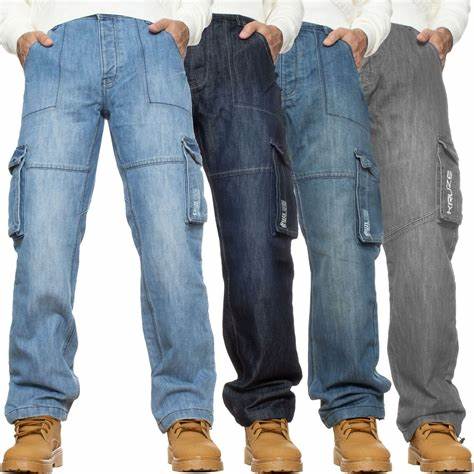
The world of casual apparel, once a clear-cut battleground between denim's enduring legacy and the utilitarian surge of cargos, is now a complex, crisscrossing landscape. Traditionally, these two categories have seen a cyclical rivalry, where the rise of one often coincides with the relative decline of the other. But in today's dynamic fashion environment, influenced by social media, celebrity endorsements, and shifting consumer preferences, the lines are blurring, and the trends are diverging across different markets.
While denim retains its iconic status, cargos are experiencing a significant resurgence, with a desire for comfort, functionality, and a touch of streetwear edge. However, this isn't a uniform trend.
Denim vs cargo playout in wardrobes
While denim enjoys global popularity, its manifestation varies significantly across different regions.
In the US, denim’s stronghold remains unwavering. "The market continues to show steady growth, with consumers showing a strong preference for fashion-forward and sustainable denim options," reflecting a blend of style consciousness and environmental awareness. However cargos are emerging strong, In the US, there’s a strong revival of the Y2K aesthetic, and cargos are a key component of that, states a report by WGSN, a trend forecasting firm. "The emphasis on practicality and a relaxed silhouette is resonating with younger consumers." This is reflected in the popularity of wide-leg cargos, parachute pants, and utility-inspired designs. For example, workwear brand Dickies has seen a massive rise in popularity, with demand for its classic 874 work pants and cargo styles growing. Their robust and durable designs are very popular. No wonder, denim, while still a staple is adapting with looser fits and vintage washes to stay relevant.
European consumers on the other hand prioritize quality and sustainability, leading to a stable demand for premium and eco-friendly denim. "The market is being shaped by a mix of fashion trends and sustainability demands," highlighting the region's commitment to responsible fashion. European markets, particularly in cities like London and Berlin, are embracing a more refined approach to cargos. "There's a focus on elevated fabrics and tailored cuts," explains a trend analyst from Euromonitor International. "Cargos are being styled with blazers and heels, reflecting a desire for versatile, smart-casual options." Denim, in contrast, is seeing a rise in sustainable and artisanal brands.
The Asia-Pacific region is a powerhouse of denim consumption, driven by rapid urbanization and rising disposable incomes. Notably, China's denim exports, valued at approximately $2.17 billion in 2021, underscore the region's important role in the global market. Rising disposable incomes, urbanization, and a growing middle class are boosting this growth. Also, the Asian market, especially in South Korea and Japan, is a hotbed of streetwear influence. "In these markets, cargos are seen as a statement piece, often featuring bold colors and oversized silhouettes," reveals a McKinsey & Company study. Denim, meanwhile, is seeing strong growth in premium and designer brands, with a focus on innovative fabrics and finishes.
The Indian market is very diverse. "Denim is a staple, but cargos are gaining traction, especially in urban youth segments," says a Technopak report. "The affordability and practicality of cargos are key drivers, particularly in Tier-II and Tier-IIIcities." The influence of Bollywood and global streetwear trends is shaping the market.
There are several key factors for these fluctuating trends. The resurgence of early 2000s fashion has pushed cargos into the spotlight. Their baggy silhouettes and utilitarian details align perfectly with this nostalgic trend. Comfort and functionality is another factor. The pandemic has shifted consumer preferences towards comfort and practicality. Cargos, with their multiple pockets and relaxed fits, offer both.
Also, the growing popularity of streetwear has blurred the lines between casual and high fashion. Cargos, with their urban edge, are a key component of this aesthetic. And influencers and celebrities are driving trends, and many have been seen sporting cargos. This has significantly boosted their popularity. Meanwhile consumers are more conscious of their environmental impact. This is driving a demand for sustainable denim and eco-friendly cargo options. Social media platforms like TikTok and Instagram are trend incubators, rapidly spreading fashion ideas and fueling demand.
Denim's rise a multifaceted phenomenon
The global denim market is projected to touch $121.50 billion by 2030. This growth underscores its undeniable strength. But what precisely fuels this rise?
Versatility and enduring appeal: Denim's inherent adaptability is a cornerstone of its success. "This growth is driven by consumers' increasing inclination toward fashionable clothing and the versatility that denim offers." From classic straight cuts to contemporary wide-leg styles, denim seamlessly transitions across various occasions, a quality that cargo pants, with their more utilitarian aesthetic, often struggle to replicate.
Nostalgia and style revival: The resurgence of flared and bootcut jeans, alongside baggy and oversized fits, taps into a powerful sense of nostalgia. These styles, championed by celebrities and influencers, resonate with consumers seeking both comfort and a touch of retro chic. "Flared jeans have been spotted on runways and in street fashion, reflecting their renewed popularity," demonstrating the power of fashion cycles.
Sustainability as a differentiator: In an increasingly eco-conscious market, denim brands are actively embracing sustainable practices. "Brands are responding by adopting eco-friendly practices, such as using recycled materials and implementing water-saving production techniques." This focus on responsible production gives denim a distinct advantage over cargo pants, which are often associated with fast-fashion and less sustainable materials.
Regional economic factors: The rapid urbanization and rising disposable incomes in Asia-Pacific are significantly bolstering denim consumption. "Factors such as rising disposable incomes, urbanization, and a growing middle class are contributing to this surge." This economic growth creates a fertile ground for denim brands to expand their market share.
Brand loyalty and iconic status: Companies like Levi Strauss & Co. leverage their iconic status and long history to maintain consumer loyalty. "CEO Michelle Gass remains optimistic about achieving the company's revenue targets, emphasizing the enduring consumer interest in denim and leveraging Levi's iconic brand status." This brand legacy is harder for emerging cargo pant brands to replicate.
Thus the future of casualwear is likely to see continued blurring of boundaries between denim and cargos. One can expect to see hybrid styles, such as denim cargos and cargo-inspired denim. The emphasis on comfort, functionality, and sustainability will continue to shape trends. "The key for brands is to be adaptable and responsive to changing consumer preferences," concludes the WGSN report. "The market is dynamic, and those who can innovate and stay ahead of the curve will thrive."
The denim-cargo conundrum is a testament to the ever-evolving nature of fashion. While the rivalry may continue, the lines are blurring, and the consumer is ultimately the winner, with a wider range of stylish and comfortable options to choose from.












